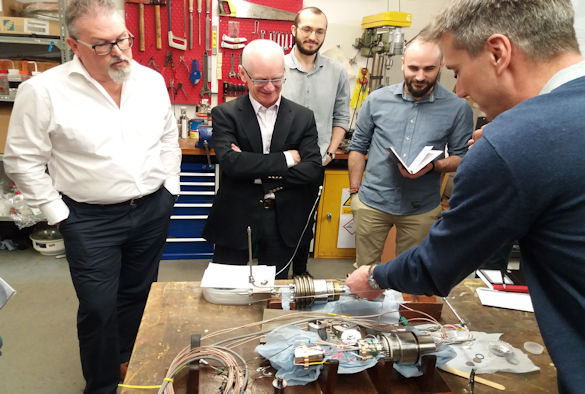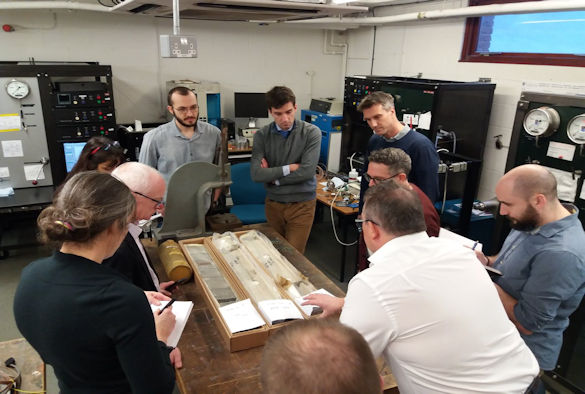
A feature article by Indira Mann, from the Scottish Carbon Capture Storage (SCCS) partnership, gives an insight into the work undertaken by the University’s Rock Deformation Laboratory which is providing its expertise to ACT Acorn, a new carbon capture and storage project in North East Scotland:
The name Captain Sandstone could well conjure up images of a Marvel superhero but, joking aside, the reality may not be so different: deep beneath the North Sea, a geological formation of that title could have what it takes to help us fight back against climate change.
The group clustered around the table in the University’s Rock Deformation Laboratory is contemplating a set of core samples extracted from the Captain X reservoir, part of the Captain aquifer system, nearly two kilometres below the seabed of the North Sea.
The Liverpool team, led by professors Dan Faulkner and Richard Worden, is hosting a visiting party of fellow researchers on a unique project, ACT Acorn, which aims to kick-start a new UK industry for storing man-made carbon dioxide (CO2) as early as 2023 and share its results with other parts of the world. With support recently secured from a European Union fund – the ERA-NET Accelerating CCS Technologies (ACT) programme – work on the feasibility study has begun in earnest.
The Captain Sandstone, and the impermeable layers of shale (or cap rock) above it, could permanently store millions of tonnes of CO2, the greenhouse gas largely responsible for escalating global warming. But before that can happen, the rocks must be put through their paces to prove their suitability. And that’s where the Liverpool team comes in.
The Department of Earth, Ocean and Ecological Sciences is celebrating one hundred years of geology at the university, but the equipment in the laboratory is very much 21st century. Most of the kit being used for the Acorn experiments has been built here, the university priding itself on innovative design.
Before selecting a suitable storage site for the Acorn project, it is important to know how the reservoir and its cap rock, which will seal the CO2 storage site, will react to well drilling, the injection of CO2 and an increasing volume of the gas (in liquid form) over time. So the team here is conducting a range of rock mechanics studies to assess the rocks’ strength and behaviour under various strains and stresses, as well as work to define their mineral content and structure.
The Captain X samples have been supplied by Nexen, with the oil company generously supplying more than the usual quantities of rock – Richard Worden recalls the forklifts being used to carry the one-metre cores to the university van. This largesse will ensure that the scientists can conduct exhaustive testing and produce highly accurate data as a result.
Michael Allen, a post-doctoral researcher, is preparing core samples the size of pound coins, which will be run through a gauntlet of experiments using various apparatus; these will measure how the rocks react under reservoir temperature and pressure during CO2 injection as well as assess their integrity as long-term stores.
Just how resistant will the rocks be to stress and strain? What is their elasticity? How much CO2 can be injected into the pore spaces between rock grains before causing fracturing? Will they withstand the drilling of new wells that will be an essential part of any CO2 storage project? These are the questions that require rigorous research before any decisions can be made about Acorn’s storage site.
The ACT Acorn project, led by Pale Blue Dot Energy, is a collaboration with Liverpool and fellow researchers from Norwegian NGO, Bellona, the Netherlands’ Radboud University, research partnership, Scottish Carbon Capture & Storage, and its partner institutes, the University of Aberdeen, University of Edinburgh and Heriot-Watt University.
Liverpool’s work will feed into storage development plans, while other areas of research include the potential re-use of North Sea oil and gas assets, recommendations for appropriate policy support, the economic aspects of a CCS industry in the UK and methods of public engagement. The work is cutting edge and, if the Acorn project is ultimately successful, it could spawn a network of carbon capture and storage (CCS) projects that will help efforts to hit climate targets enshrined in the Paris Agreement.
Asked to define the significance of Liverpool’s input, Dan Faulkner says: “We’re using our own design of equipment made specifically for the results we seek. It’s a real advantage for a lab to be able to do that. We’re trying to push boundaries here and do experiments not possible elsewhere.
“The Captain Sandstone is huge and it has the capacity and potential to store Scotland’s emissions for decades. CCS is important worldwide because, if we don’t find somewhere to store our excess carbon, we are unlikely to hit the targets needed to avoid the worst impacts of climate change.”
The partners head next to another lab housing machinery worthy of a Bond film. This is where electron microscopy and other microstructural analysis techniques will give the scientists a very clear character profile of each rock, from mineral content and provenance to pore space.
James Utley, who is also heavily involved in the Acorn work, says: “If you really need to know mineralogy then our combination of QEMSCAN analysis and x-ray diffraction is the kit to use. These together reveal not only the chemistry but also the crystal structure of a rock. Each mineral has its own fingerprint, and its own history, which our equipment can identify. To get a clear picture, you tend to have to use these two approaches and that’s what we’ll be doing for Acorn.”
The QEMSCAN, a specialist electron microscope, has its own story to tell. As Richard Worden recalls: “I had a chance meeting with a former PhD student who used to teach me when I was an undergraduate in the 1980s. He’d gone to work for CSIRO, Australia’s national research agency. They had this innovative piece of equipment worth $1m and they wanted to demonstrate its usefulness to the oil industry. They loaned us the scanner 18 months ago and we’ve been able to make very good use of it ever since. For Acorn, it will be invaluable.”
The QEMSCAN uses very quick and clever software. Different minerals are tagged on a database – quartz is shown as pink, the colours chosen manually by the operator – and, as an electron beam passes over the sample, the software matches results to the library of minerals. It can be used at a high speed to give an idea of the minerals present or slowed right down to produce highly detailed results.
James said: “This equipment can do many things that optical petrology could do with ease: porosity, structure, composition; but it’s not a replacement technique. It adds to the battery of techniques and equipment that can answer any questions we have about different rocks, and that’s very important for CCS. The strength of our research here is that we are combining two approaches, geo-mechanical data and rock characteristics, and this will give an extremely reliable picture of the Captain X reservoir and its cap rock.”
That’s good news for the Acorn team, who will also be assessing a second reservoir, East Mey, and ultimately putting forward their chosen candidate for the UK’s first full-chain CCS project. In a world facing the consequences of runaway climate change, Captain Sandstone may yet prove to be the superhero we’re looking for.
